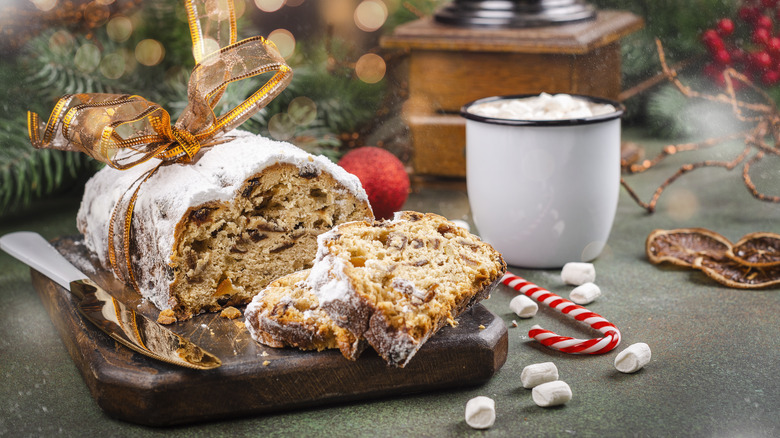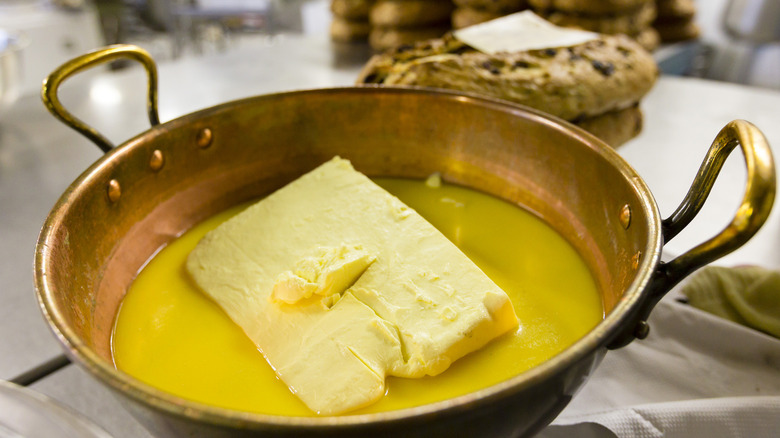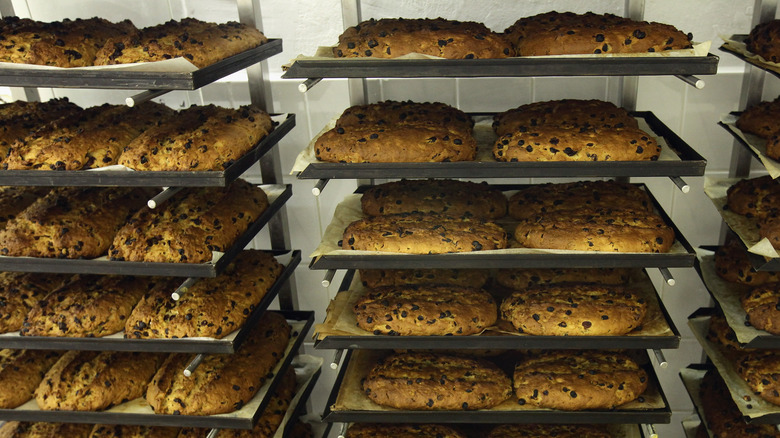Stollen Needed A Pope's Approval To Become The Christmas Treat It Is Today
There are many reasons to love and appreciate a mouthwatering, well-made stollen, the icing sugar-dusted Christmas bread filled with spirit-soaked fruit, nuts, and, in some cases, a roll of marzipan.
Stollen is not for the timid. Food52's version of this classic holiday bread features raisins, currants, dried cherries, candied orange peel, and lemon zest, steeped in a generous glug of rum or brandy before it is baked into a rich yeasted dough with milk, sugar, and a generous helping of butter.
While stollen is enjoyed around the world today, the festive bread has its roots in 15th-century Dresden, the seat of the German state of Saxony, which was known for playing a role in Europe's religious Reformation movement, per the Library of Congress. As such, it shouldn't come as much of a surprise that the church played a significant role in everyday life.
The European Commission's (EC) Agriculture and rural development site says stollen could well have been invented during the 14th century as a baking contest entry held by a bishop. But it couldn't have been an exciting pastry from the get-go because it was originally considered to be a fasting food, and as such, two critical ingredients for today's stollen — milk and butter — were banned from stollen's ingredient list, per What's Cooking America. In place of the dairy, the European Commission says oil was used, making for a rather bland holiday bread.
It took a pope to lift the butter ban on making stollen
In order to try and get the church to cut Saxony's bakers some slack, the region's nobles — Prince Ernst and his brother, Duke Albrecht, decided to petition the sitting pope, Nicholas V, to make an exception for the region's stollen in 1490, and allow for the use of butter in the pastry. But the Supreme Pontiff of the time refused, leaving the pastry in gastronomical limbo. An exemption for Saxony's bakers known as the "Butterbrief" was eventually issued by one of Nicholas V's successors, Innocent VIII, but it took a while — four decades and four popes later, to be exact, per the EC's Agriculture and rural development site.
The ingredient swap propelled stollen, which had also become known as "Christstollen," to popularity, and by the mid-16th century, Dresden's bakers began sending stollen to Saxony's rulers every Christmas as a holiday tradition. One of the splashiest loaves that came out of the post-butter ban era was a 1.8-tonne stollen made by 100 bakers in 1730, who needed 3,600 eggs, 326 churns of milk, and "20 hundredweight of flour."
The making of authentic stollen is protected by the EU
While anyone can make the holiday treat today, only a select few will get a special gold seal of approval. One type of the Christmas bread, the "Dresdner Christstollen PGI," is manufactured by a select group of bakeries located in the Dresden area under the supervision of the Stollen Association, which has been around since 1991. The group appoints an independent council to oversee the production of stollen at more than 120 member bake shops in a process that takes place over an 18-day period before any stollen is given a seal of approval.
Unfortunately, if you love the marzipan center in your stollen, you may want to give the authentic stuff a pass because there is little to no creativity is allowed in the making of traditional stollen. Per the Stollen Association, an authentic, traditional pastry is made strictly with "raisins, butter, sweet and bitter almonds, candied orange and lemon peel, flour, water and yeast, [as well as] whole milk or whole milk powder, crystal sugar, clarified butter, lemon zest, table salt, powder sugar, stollen spices and spirits." No artificial preservatives, flavors, or margarine can be used, either.


